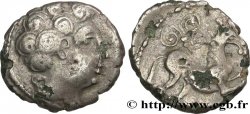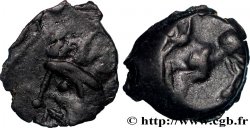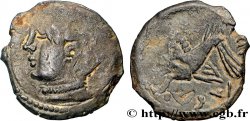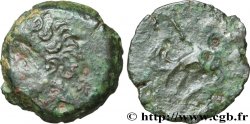Live auction - bga_823857 - GALLIA - ARVERNI (Area of Clermont-Ferrand) Statère d’or au nom de VERCINGETORIXS, classe à l’amphore et au S couché
得先注册又得到批准才可以报价。为了报价注册. 客户应该得到公司允许,那种过程需要 48 个小时。别等出售结束那一天才登记。您报价的话等于您赞成买那物品,而且按« 保价 » 证明您接受 cgb.fr 因特网拍卖使用法.
报价时只可以出全数值欧元总额。物品描述也说明销售结束时间,结束后出价都不会生效。 报价命令转达有时变动,等到最后秒钟增加否决的可能会。想多了解的话请注意 因特网拍卖常问
最高出价方将支付18%的不含税的拍卖费用
最高出价方将支付18%的不含税的拍卖费用
| 估算 : | 250 000 € |
| 价格 : | 390 000 € |
| 最高出价 : | 390 000 € |
| 拍卖结束日期 : | 06 June 2023 16:42:58 |
| 竞拍人 : | 2 竞拍人 |
种类 Statère d’or au nom de VERCINGETORIXS, classe à l’amphore et au S couché
日期: 58-52 avant J.-C.
材质 gold
直径 17,5 mm
模子方针 10 h.
重量 7,44 g.
稀少度 R3
关于品相的说明
Bel exemplaire sur un flan bien centré au droit. Éclatement de flan à 12 heures au droit se retrouvant à 2 heures au revers. La légende VERCINGETORIXS est presque complète ! Rayure sur l’arrière de la joue. Revers agréable avec un joli cheval. Légère patine de collection
出版目录中的项代码 :
家谱
Monnaie provenant de la collection André Libaud
Avec son certificat d'exportation de bien culturel n°225122 délivré par le ministère français de la Culture
正面
正面的文字 VERCI-NGETO[RIXS].
正面的说明书 Tête nue à gauche, la chevelure ondulée ; légende commençant devant le menton, se terminant derrière la nuque ; grènetis.
背面
背面的文字 ANÉPIGRAPHE.
背面的说明书 Cheval bondissant à gauche, un S couché au-dessus du dos (et une amphore entre les jambes).
评论
Exemplaire publié dans le Nouvel Atlas des Monnaies Gauloises de Louis-Pol Delestrée et Marcel Tache (janvier 2007, sous le n° 3599, p. 151 et pl. XXVI), et dans les Cahiers Numismatiques n°200 du 1er juin 2014 (p. 31, Fig. II). Ce statère appartient à la série monétaire gauloise la plus populaire et la plus recherchée par les numismates.
Les statères d’or de la série VERCINGETORIXS sont décrits selon trois classes par Delestrée et Tache : classes I-II pour les avers à tête nue et avec le revers à l’amphore et au S couché (classe I à laquelle ce statère appartient) ou à l’amphore et au croissant (classe II). Les statères d’or de la classe III présentent au droit une effigie casquée.
example published in the New Atlas of Gaulish Coins by Louis-Pol Delestrée and Marcel Tache (January 2007, under no. 3599, p. 151 and pl. XXVI), and in the Cahiers Numismatiques no. 200 of June 1, 2014 (p. 31, Fig. II). This stater belongs to the most popular and sought-after Gallic monetary series by numismatists. The gold staters of the VERCINGETORIXS series are described according to three classes by Delestrée and Tache: classes I-II for the obverses with a bare head and with the reverse with an amphora and a recumbent S (class I to which this stater belongs) or with an amphora and a crescent (class II). The gold staters of class III present on the obverse a helmeted effigy
Les statères d’or de la série VERCINGETORIXS sont décrits selon trois classes par Delestrée et Tache : classes I-II pour les avers à tête nue et avec le revers à l’amphore et au S couché (classe I à laquelle ce statère appartient) ou à l’amphore et au croissant (classe II). Les statères d’or de la classe III présentent au droit une effigie casquée.
example published in the New Atlas of Gaulish Coins by Louis-Pol Delestrée and Marcel Tache (January 2007, under no. 3599, p. 151 and pl. XXVI), and in the Cahiers Numismatiques no. 200 of June 1, 2014 (p. 31, Fig. II). This stater belongs to the most popular and sought-after Gallic monetary series by numismatists. The gold staters of the VERCINGETORIXS series are described according to three classes by Delestrée and Tache: classes I-II for the obverses with a bare head and with the reverse with an amphora and a recumbent S (class I to which this stater belongs) or with an amphora and a crescent (class II). The gold staters of class III present on the obverse a helmeted effigy







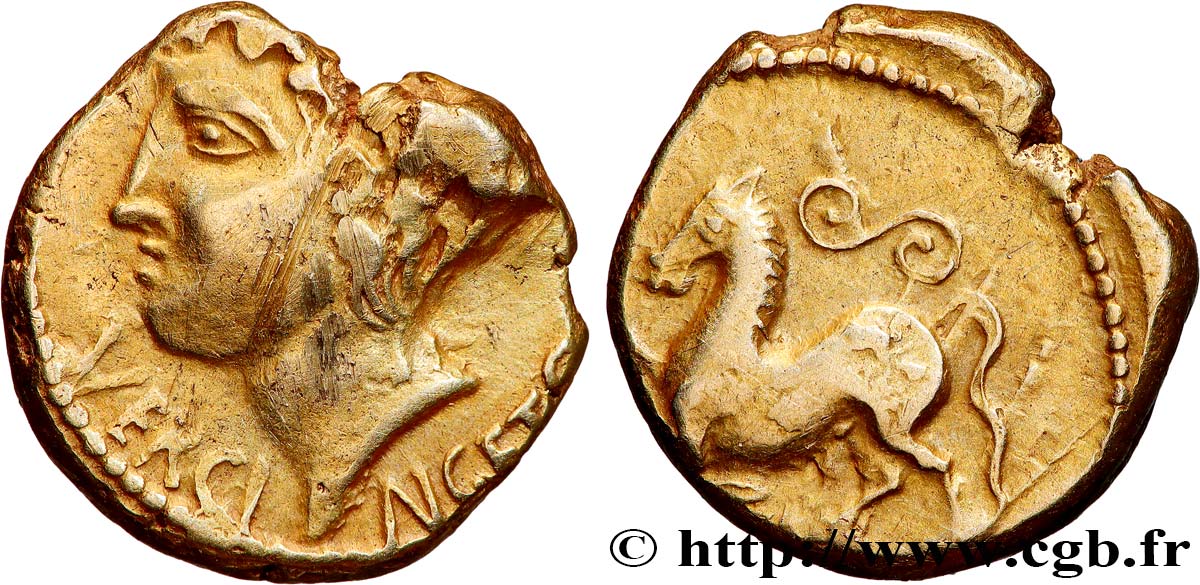
 对产品描述纠错
对产品描述纠错 打印
打印 分享我的选择
分享我的选择 提问
提问 Consign / sell
Consign / sell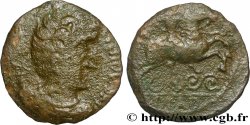
 产品介绍
产品介绍